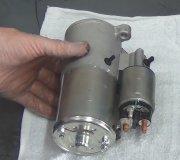Any electrical power at all? Lights, radio, etc...?
Here's a tech bulliten on har/no start symtom.
Classification: EC96-004 Section: Engine Control System Bulletin No.: ITB96-018 Date: April 17, 1996 SERVICE INFORMATION This bulletin has been developed to address complaints of an engine which cranks over normally, but is difficult to start or will not start at all. SERVICE PROCEDURE 1. Connect CONSULT. 2. Start the engine (the accelerator may have to be opened and/or the fuel pump fuse removed during cranking to get the engine to start), and warm it to operating temperature. 3. Run the engine at 2000 rpm (no load) for two minutes. Then shut the engine off. 4. Check the oil level and correct if necessary (between the "L" and "H" marks on the dipstick). If the oil level is overfull and has a gasoline odor, change the oil and filter before performing this procedure. If the crankcase is overfull with oil, idle speed adjustment may be affected. 5. Disconnect the throttle position sensor (TPS) connector. Now re-start the engine. 6. Rev the engine 2 or 3 times to 2000-3000 rpm, then allow it to idle (all accessories "off"). 7. Check the ignition timing with a timing light and adjust it to specification (if necessary). 8. Using CONSULT, perform the following procedure, See Fig. 1 . Monitor the idle speed (CMPS*RPM) on the CONSULT screen. 9. Check the idle rpm and adjust to specification (if necessary) using the screw on the IACV- AAC valve. The table below shows ignition timing and base idle speed for some models. NOTE: If the engine will not start after performing the above procedure, clean and dry the spark plugs, and attempt to start the engine again. NOTE: When the engine is in this condition (TPS disconnected), the IACV-AAC valve and the ignition timing are held in a "fixed position, and the idle speed is called "base idle." If the engine stalls with the TPS disconnected, the base idle speed is adjusted too low. Temporarily increase the base idle speed by turning the adjusting screw on the IACV-AAC valve until the engine will idle. NOTE: On 1990-1992 M30's (F31), the IACV-AAC valve must be disconnected to adjust the base idle speed.If the model or model year you are working on is not listed, refer to the appropriate service manual (EF & EC) section. and perform the "IDLE SPEED/IGNITION TIMING/IDLE MIXTURE RATIO INSPECTION" procedure. 10. Turn the engine off, and re-connect the TPS. J30 1. If the base idle speed is within specification and the vehicle has experienced hard starting following a short driving cycle, install the countermeasure starter motor assembly. Refer to the appropriate service manual (EL section) for installing the starter motor. 2. Review the starting information (below) with the customer. 3. If the customer continues to experience hard starting after installing the countermeasure starter motor assembly, please contact TECH LINE for assistance.

Last half of lastest bulliten:
STARTING INFORMATION FOR CUSTOMER Short Driving Cycles - Q45, J30, I30 and G20 Modern multi-valve engines designed for efficient low-friction operation may sometimes experience carbon build-up on the valves after driving a very short duration (less than 1 minute). A hard start or no start incident may occur on the next starting attempt. If this pattern is observed, the vehicle can be started by following the cold weather starting procedure below. Cold Weather Starting - All Models During cold whether, Nissan suggests the following procedure to make starting the vehicle easier when this incident occurs. This procedure is a continuation of the procedure outlined in the owner's manual and should be used to remedy a "No Start" condition when the ambient temperature is low. 1. Depress the accelerator pedal approximately 1/3 of the way to the floor. 2. Hold the accelerator pedal in this position and crank the engine. 3. Once the engine has started, release the accelerator pedal. (Do not race the engine while warming it up.) 4. If the engine does not start within 10 seconds, wait at least 10 seconds and repeat steps 1 through 3. Once the engine is started in cold weather conditions, run the engine for a minimum of 2 to 3 minutes before shutting it off. Starting and stopping the engine over a short period of time may make the vehicle more difficult to re-start. This type of usage may also adversely affect a vehicle's fuel economy. Another factor that may affect a vehicle's starting performance in cold weather conditions is the viscosity or thickness of the engine oil that is used. An API SG or SH quality 5W-30 is the preferred engine oil to be used year-round for most models. In colder weather, oil that is rated 5W-30 will not thicken as much as a 10W-30 rated oil; this makes it easier to start the engine and maintain a stable idle during warm up.

Monday, October 19th, 2009 AT 2:13 PM





